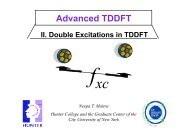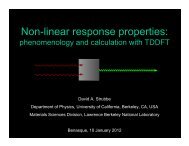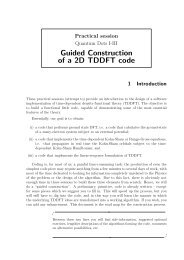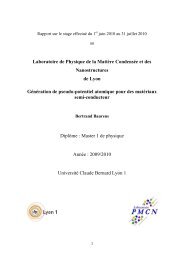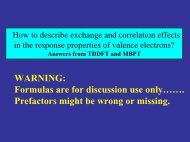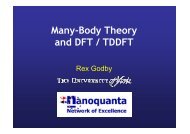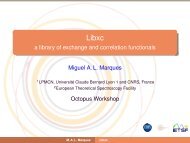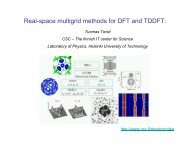Introduction to the octopus code - TDDFT.org
Introduction to the octopus code - TDDFT.org
Introduction to the octopus code - TDDFT.org
Create successful ePaper yourself
Turn your PDF publications into a flip-book with our unique Google optimized e-Paper software.
section 1. <strong>Introduction</strong> 3<br />
The time-dependence of <strong>the</strong> exchange and correlation potential introduces <strong>the</strong> need<br />
for an approximation beyond <strong>the</strong> one made in <strong>the</strong> time-independent case. The simplest<br />
method of obtaining a time-dependent xc potential consists in assuming that<br />
<strong>the</strong> potential is <strong>the</strong> time-independent xc potential evaluated at <strong>the</strong> time-dependent<br />
density, i.e.,<br />
v xc ([ρ];⃗r, t) ≃ v xc ([ρ];⃗r)| ρ≡ρ(⃗r,t)<br />
. (7)<br />
This is called <strong>the</strong> adiabatic approximation. If <strong>the</strong> time-independent xc potential chosen<br />
is <strong>the</strong> LDA, <strong>the</strong>n we obtain <strong>the</strong> so-called adiabatic local density approximation<br />
(ALDA). This approximation gives remarkably good excitation energies but suffers<br />
from <strong>the</strong> same problems as <strong>the</strong> LDA, most notably <strong>the</strong> exponential fall-off of <strong>the</strong><br />
xc potential. If a strong laser pushes <strong>the</strong> electrons <strong>to</strong> regions far from <strong>the</strong> nucleus,<br />
ALDA should not be expected <strong>to</strong> give an accurate description of <strong>the</strong> system.<br />
O<strong>the</strong>r options for <strong>the</strong> time-dependent xc potential are, e.g., <strong>the</strong> orbital-dependent<br />
potentials like <strong>the</strong> exact exchange functional (EXX) (usually in <strong>the</strong> Krieger-Li-<br />
Iafrate (KLI) approximation).<br />
• Pseudopotentials<br />
The many-electron Schrödinger equation can be greatly simplified if electrons are<br />
divided in two groups: valence electrons and inner core electrons. The electrons<br />
in <strong>the</strong> inner shells are strongly bound and do not play a significant role in <strong>the</strong><br />
chemical binding of a<strong>to</strong>ms, thus forming with <strong>the</strong> nucleus an inert core. Binding<br />
properties are almost completely due <strong>to</strong> <strong>the</strong> valence electrons, specially in metals<br />
and semiconduc<strong>to</strong>rs. This separation implies that inner electrons can be ignored,<br />
reducing <strong>the</strong> a<strong>to</strong>m <strong>to</strong> an inert ionic core that interacts with <strong>the</strong> valence electrons.<br />
This suggests <strong>the</strong> use of an effective interaction, a pseudopotential, that gives an<br />
approximation <strong>to</strong> <strong>the</strong> potential felt by <strong>the</strong> valence electrons due <strong>to</strong> <strong>the</strong> nucleus and<br />
<strong>the</strong> core electrons. This can significantly reduce <strong>the</strong> number of electrons that have<br />
<strong>to</strong> be dealt with. Moreover, <strong>the</strong> pseudo wave functions of <strong>the</strong>se valence electrons<br />
are much smoo<strong>the</strong>r in <strong>the</strong> core region than <strong>the</strong> true valence wave functions, thus<br />
reducing <strong>the</strong> computational burden of <strong>the</strong> calculations.<br />
Modern pseudopotentials are obtained by inverting <strong>the</strong> free a<strong>to</strong>m Schrödinger equation<br />
for a given reference electronic configuration, and forcing <strong>the</strong> pseudo wave<br />
functions <strong>to</strong> coincide with <strong>the</strong> true valence wave functions beyond a certain cu<strong>to</strong>ff<br />
distance. The pseudo wave functions are also forced <strong>to</strong> have <strong>the</strong> same norm as <strong>the</strong><br />
true valence wave functions, and <strong>the</strong> energy pseudo eigenvalues are matched <strong>to</strong> <strong>the</strong><br />
true valence eigenvalues. Different methods of obtaining a pseudo eigenfunction<br />
that satisfies all <strong>the</strong>se requirements lead <strong>to</strong> different non-local, angular momentum<br />
dependent pseudopotentials. Some widely used pseudopotentials are <strong>the</strong> Troullier<br />
and Martins [9] potentials, <strong>the</strong> Hamann [10] potentials, <strong>the</strong> Vanderbilt [11] potentials<br />
and <strong>the</strong> Hartwigsen-Goedecker-Hutter [12] potentials. The default potentials<br />
used by oc<strong>to</strong>pus are of <strong>the</strong> Troullier and Martins type, although you can also opt<br />
for <strong>the</strong> HGH potentials.<br />
Besides <strong>the</strong>se usual DFT approximations, <strong>the</strong> use of oc<strong>to</strong>pus implies ano<strong>the</strong>r approximation,<br />
which stems from <strong>the</strong> particular calculation method used.



